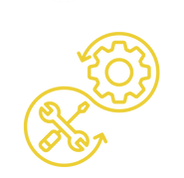SECTION 1: STORMS
CHAPTER 17 - STORMS ARE STORIES
There are just 3 types of challenge and we can handle every one of them.


In natural ecosystems, the species that survive have adapted to change around them. But many organizations perish because they fail to prepare for crises and opportunities within and around them. Often, we face crises and tell ourselves, "this too shall pass," or regret missed opportunities, rather than readying ourselves in advance.
Understanding and creating storms
Every storm is a tale with a beginning, a middle and an end. Although we cannot predict the weather with perfect accuracy, we can equip ourselves for what may come and build resilience to likely or potential storms.
We can also create storms ourselves. For example taking direct action can destabilize a system, hinder an opponent and drive public debate around your issue.
Navigating storm types
To comprehend how a storm might impact our target system or our campaign, we categorize it into three types:
-
Developmental: Challenges a system’s identity or boosts its visibility.
-
Situational: Hinders a system’s operations or enhances its influence.
-
Existential: Threatens a system’s survival or enables evolution to something stronger.
Analyzing causes and effects
To effectively handle a storm, we must analyze its causes and consequences. This involves identifying whether the problem is simple, complicated, complex or chaotic (see Chapter 2), observe its five system levels (Chapter 3), its Guiding Star and Near Star (Chapter 5) and the Deep Loop that drives it (Chapter 8).
Preparing for impact
Do not underestimate the impact of a storm or your ability to deal with it. Bats’ echolocation is disrupted by storms, preventing them from perceiving their environment. They take shelter and wait out the storm. But the hard truth for campaigners and organizations is that taking shelter is rarely the best option to deal with a crisis or opportunity. When we prepare in advance, we can be ready for all kinds of circumstances.
Make sure you read all the chapters in this Section in order to prepare and deal with the three types of storm, because the storms will come. You will fare far better if you prepare in advance. No one wants to lurch from crisis to crisis.
Footnotes: Aboriginal season charts: https://www.csiro.au/en/research/Indigenous-science/Indigenous-knowledge/calendars
Chart showing Aboriginal Australian fire burning according to season: https://www.researchgate.net/figure/A-seasonal-calendar-illustrating-aspects-of-Indigenous-fire-stewardship-The-calendar_fig2_359670046
“A crisis is an opportunity riding a dangerous wind” - Chinese proverb
.png)
tool: storm diagnosis
Spotting threats:
Draw out or print the Storm Chart. Write on one Post It at a time:
-
A challenge or opportunity you might face
-
Write down whether it relates to:
-
the system you’re trying to change
-
your campaign
-
both
-
-
Write down its corresponding Storm type:
-
Developmental: An challenge to a system’s identity of or an opportunity to raise its profile
-
Situational: A challenge impeding what the system does or an opportunity to boost its reach
-
Existential: A threat to a system’s existence or an opportunity to create something stronger
-
-
Write down whether this threat or opportunity in itself is:
-
Chaotic
-
Complex
-
Ordered
-
-
Place the Post-It on the Threat / Opportunity ring in line with the Storm type.
Continue this process for all the possible threats you could face. There should be a fairly even distribution of Post-Its.
Storm as system: On an A3 sheet, pick the most harmful, most likely threat. Note down:
-
Why: Why has this threat come to happen. Is it because of your campaign?
-
Who: The storm’s Guiding Star and Near Star. The key relationships that give it equilibrium, power and set the rules for how it operates.
-
Where: The relationships that allow information to flow and enable the threat to function.
-
How: How the storm manifests.
-
What: The short, medium and long term impacts are, on you and others in and outside the system.
Does this tell you anything new to prepare for, in how the storm affects the system or your campaign?
Eye of the storm:
-
On a separate sheet, draw out the key loops that you think are driving this storm.
-
Add arrows to show direction, and pluses and minuses alongside them to show where some elements increase or decrease others.
-
Identify the loops as stabilizing / stagnating / vicious / virtuous.
-
Review the loops and identify the most critical ones.
-
Zoom out. Could you see these loops together as one large loop?
-
What does this tell you about what is driving the storm, and how you could deal with it?
Is the storm a threat or opportunity as you originally believed? Could it evolve into one, or could you turn it to your advantage?





story: stopping arms
transportation to zimbabwe,
south africa

During the 2008 elections in Zimbabwe, the ruling party ZANU-PF suppressed opposition and manipulated results. Meanwhile, a Chinese ship carrying weapons for Zimbabwe's Defense Force arrived in South Africa for the arms to be sent to Zimbabwe, raising fears of increased violence.
Civil society groups in South Africa aimed to prevent the ship from delivering weapons to Zimbabwe, thereby avoiding further violence and human rights abuses. They did so by understanding the type of crisis and opportunity and responding to them appropriately:
There were three interrelated crises:
-
Developmental Crisis:
-
False election results. This was a symptom of the deeper situational and existential crises. Dealing with those was more critical.
-
-
Situational Crises:
-
Voter suppression and manipulation of results.
-
The arrival of the ship carrying weapons. This needed addressing immediately or it would risk an existential crisis - the lives of people in Zimbabwe.
-
-
Existential Crises:
-
The potential for increased state violence and suppression of the opposition.
-
Zimbabwe's long-term struggle with corruption and political violence.
-
Addressing these would take longer, but understanding their connection to the situational crises were important for building strength across civil societies in the long fight against repression.
-
Campaigners took coordinated action:
-
Using voice at the What level: Religious groups and NGOs in South Africa protested at the Durban harbor.
-
Blocking infrastructure at the How level: The South African Transport and Allied Workers Union refused to offload the weapons. Civil society groups and unions in Mozambique, Namibia, and Angola coordinated to prevent the ship from docking and offloading weapons in their countries.
-
Legal challenge at the Who level: The Southern African Litigation Centre (SALC) filed a legal challenge to stop the transfer of weapons.
Results:
-
System sabotage: Unions, religious groups and NGOs navigated the connected storms to stop the system from functioning. The ship could not offload its weapons cargo in any of the ports, and eventually returned to China.
-
Legal and social impact: The campaign highlighted the willingness of regional leaders to support Zimbabwe’s lawlessness and spurred public outrage.
-
Showed strength of future regional solidarity and resistance: It sent a clear message against state violence in Zimbabwe.
Read more:
https://www.business-humanrights.org/en/latest-news/chinese-arms-to-zimbabwe/
https://www.industriall-union.org/archive/imf/unions-block-arms-delivery-to-zimbabwe
https://www.theguardian.com/world/2008/apr/24/zimbabwe.china






